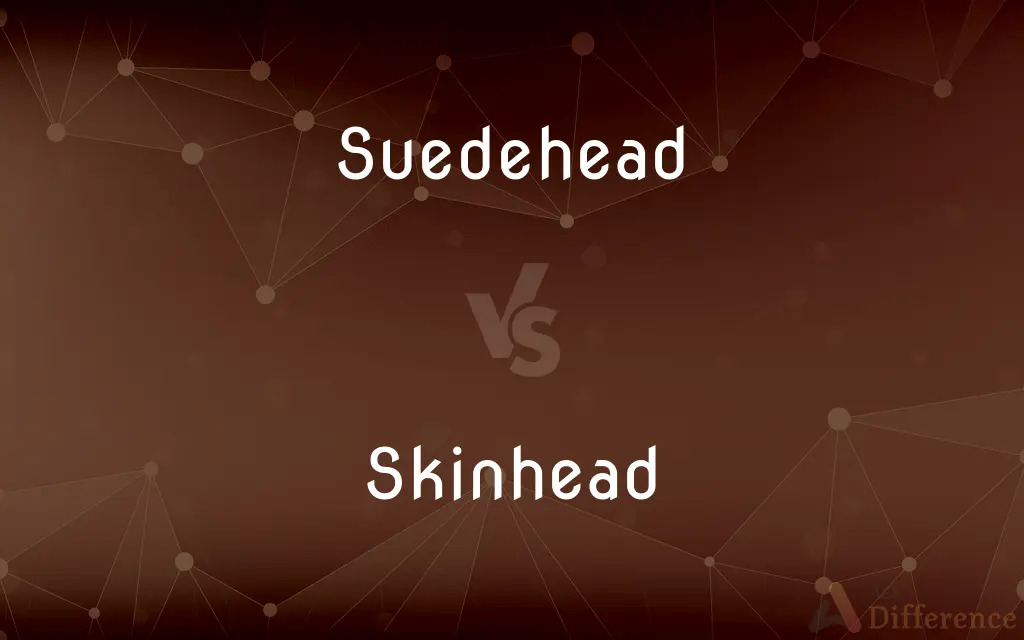Suedehead vs. Skinhead — What's the Difference?
By Urooj Arif & Maham Liaqat — Updated on April 25, 2024
Suedeheads evolved from skinheads, embracing a cleaner, more refined style and softer music tastes, whereas skinheads were often associated with harder punk music and more aggressive fashion.

Difference Between Suedehead and Skinhead
Table of Contents
ADVERTISEMENT
Key Differences
Suedeheads emerged in the early 1970s as an offshoot of the skinhead subculture, focusing on a more sophisticated appearance, while skinheads originated in the 1960s, often characterized by their working-class pride and distinctive aggressive style.
Suedeheads typically wore smarter attire such as brogues, loafers, and neatly pressed shirts, whereas skinheads were known for their Dr. Martens boots, braces, and shaved heads.
Suedeheads leaned towards soul, reggae, and rocksteady, reflecting their smoother, more mod-influenced style, while skinheads were more directly associated with punk rock and Oi!, which emphasized their rougher, rebellious ethos.
The suedehead subculture was seen as an evolution towards a less confrontational and more mature demeanor, whereas the original skinhead identity was closely tied to youth rebellion and at times, political extremism.
Both subcultures have their roots in the UK, but suedeheads represented a shift towards a more mainstream and less polarizing image compared to the often stigmatized skinhead image.
ADVERTISEMENT
Comparison Chart
Origin
Early 1970s, UK
1960s, UK
Fashion
Brogues, loafers, neat shirts
Dr. Martens boots, braces, jeans
Music Preferences
Soul, reggae, rocksteady
Punk rock, Oi!
Cultural Image
More refined, mature
Aggressive, rebellious
Public Perception
Less confrontational, more accepted
Often linked with extremism
Compare with Definitions
Suedehead
Known for their interest in soul and early reggae music.
As a suedehead, he spent his weekends scouring record shops for rare reggae vinyl.
Skinhead
Often associated with punk music and a rebellious attitude.
His skinhead lifestyle was a direct expression of his love for punk rock and defiance.
Suedehead
A subculture that evolved from skinheads, characterized by a cleaner, more sophisticated style.
He adopted the suedehead style, favoring sharp clothes and smooth soul music.
Skinhead
A subculture known for its close-cropped or shaved heads and working-class ethos.
The skinheads gathered at the concert, easily recognizable by their shaved heads.
Suedehead
Suedeheads often maintained longer hair than the traditional skinhead buzz cuts.
Moving away from the skinhead look, he let his hair grow into a typical suedehead style.
Skinhead
Skinheads' fashion includes boots, tight jeans, and braces.
Clad in Dr. Martens and braces, the skinhead's outfit was quintessentially rebellious.
Suedehead
Emphasized a more mature, less confrontational fashion style.
His suedehead attire included polished loafers and finely knit sweaters.
Skinhead
Originated as part of the British working-class youth culture.
Originating in the 60s, skinhead culture was initially a manifestation of working-class pride.
Suedehead
Generally perceived as less aggressive compared to skinheads.
Unlike the aggressive reputation of skinheads, he was known for the more subdued suedehead demeanor.
Skinhead
Sometimes linked with political extremism and violence.
The group of skinheads at the rally were mistakenly identified with extremist ideologies.
Suedehead
"Suedehead" is the debut solo single of English singer Morrissey, released on 15 February 1988. The track was featured on Morrissey's debut album, Viva Hate, and the compilation album Bona Drag, the latter of which also featured the B-side "Hairdresser on Fire".
Skinhead
A skinhead is a member of a subculture which originated among working class youths in London, England, in the 1960s and soon spread to other parts of the United Kingdom, with a second working class skinhead movement emerging worldwide in the late 1970s. Motivated by social alienation and working class solidarity, skinheads (often shortened to "skins" in the UK) are defined by their close-cropped or shaven heads and working-class clothing such as Dr.
Suedehead
A member of an offshoot of the British skinhead subculture, originating in the 1970s and characterised by longer hair and more formal clothing than the skinheads.
Skinhead
A person with a shaven head or very close cropped hair, especially one who associates with a group of similar people.
Skinhead
Such a person who associates with a group that commits hooliganism or street violence or that holds white supremacist or anti-immigrant views.
Skinhead
Someone with a shaved head.
Skinhead
A member of a subculture that arose among working-class youth in late 1960s England or its diaspora, defined by close-cropped or shaven heads and working-class clothing, and often incorrectly associated with violence and white-supremacist or anti-immigrant principles.
Fresh cut
Skinhead
A young person who belongs to a British or American group that shave their heads and gather at rock concerts or engage in white supremacist demonstrations
Common Curiosities
Are suedeheads associated with political movements like some skinheads?
Suedeheads are typically not as closely associated with political movements as skinheads, who have at times been linked with various political extremes.
What type of music do suedeheads prefer?
Suedeheads generally prefer soul, reggae, and rocksteady, distinguishing their tastes from the punk and Oi! music popular among skinheads.
Why did the suedehead subculture develop?
The suedehead subculture developed as a progression from skinheads, seeking a more mature and less confrontational identity.
What geographical areas did suedeheads and skinheads originate from?
Both suedeheads and skinheads originated in the United Kingdom, particularly influenced by the urban and working-class cultures of cities like London.
What led to the evolution from skinheads to suedeheads?
The transition from skinheads to suedeheads was largely a response to the desire for a less militant and more stylish image, moving away from the more aggressive elements of the skinhead culture towards a more refined and fashionable demeanor.
How did suedeheads differ from skinheads in terms of fashion?
Suedeheads wore smarter, more sophisticated clothing like brogues and neatly pressed shirts, unlike skinheads who preferred rugged boots and casual wear.
How do public perceptions of suedeheads and skinheads differ?
Public perceptions vary significantly: suedeheads are generally seen as less confrontational and more socially acceptable, whereas skinheads have been more controversial, often stigmatized due to associations with violence and extremism.
What is a suedehead?
A suedehead is a person associated with a subculture that evolved from skinheads, known for a more refined fashion and music taste.
Can suedeheads and skinheads be identified by their hairstyles?
Yes, hairstyles are a key distinguishing feature. Suedeheads often have slightly longer hair, sometimes styled in a more polished manner, while traditional skinheads are known for their very short or shaved heads.
Are there any common misconceptions about suedeheads and skinheads?
A common misconception is that all skinheads are involved in political extremism or racism, which overlooks the diverse and often non-political roots of the culture. Conversely, suedeheads are sometimes mistakenly seen as merely a fashion-focused offshoot without understanding their distinct musical and cultural preferences.
Share Your Discovery

Previous Comparison
Stagnant vs. Stagnate
Next Comparison
Columnar vs. ShapeAuthor Spotlight
Written by
Urooj ArifUrooj is a skilled content writer at Ask Difference, known for her exceptional ability to simplify complex topics into engaging and informative content. With a passion for research and a flair for clear, concise writing, she consistently delivers articles that resonate with our diverse audience.
Co-written by
Maham Liaqat














































